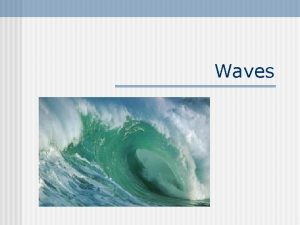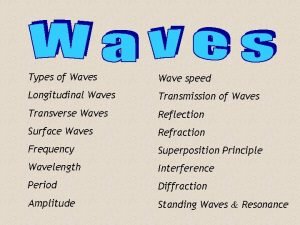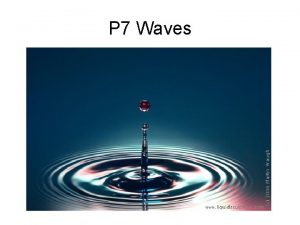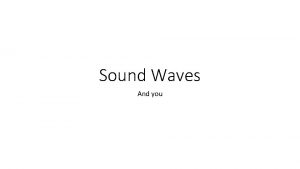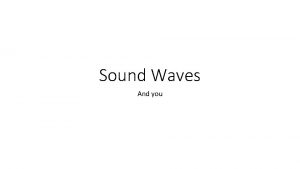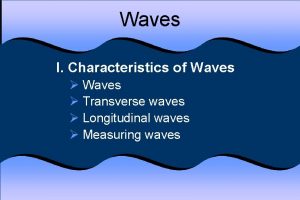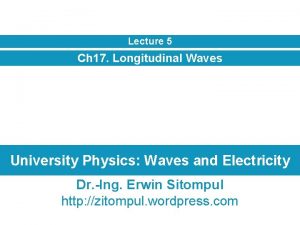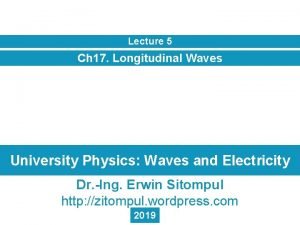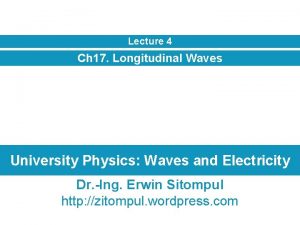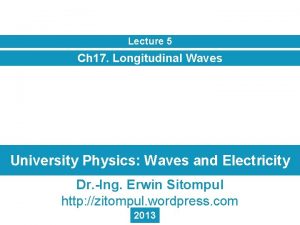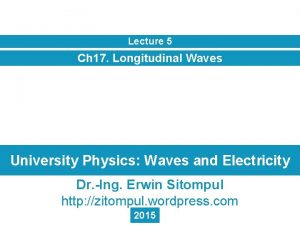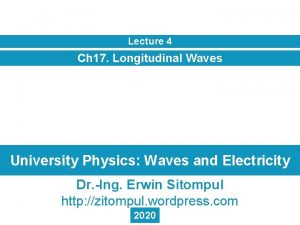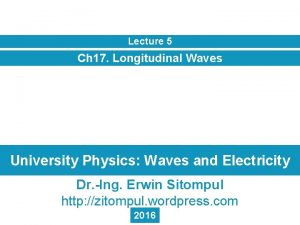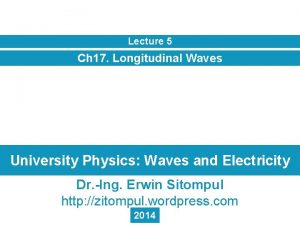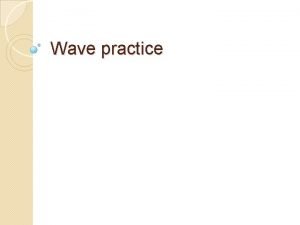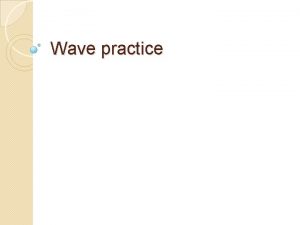Lecture 5 Ch 17 Longitudinal Waves University Physics






















- Slides: 22

Lecture 5 Ch 17. Longitudinal Waves University Physics: Waves and Electricity Dr. -Ing. Erwin Sitompul http: //zitompul. wordpress. com

Homework 4: Two Speakers Two speakers separated by distance d 1 = 2 m are in phase. A listener observes at distance d 2 = 3. 75 m directly in front of one speaker. Consider the full audible range for normal human hearing, 20 Hz to 20 k. Hz. Sound velocity is 343 m/s. (a) What is the lowest frequency fmin, 1 that gives minimum signal (destructive interference) at the listener’s ear? (b) What is the second lowest frequency fmin, 2 that gives minimum signal? (c) What is the lowest frequency fmax, 1 that gives maximum signal (constructive interference) at the listener’s ear? (d) What is the highest frequency fmax, n that gives maximum signal? Erwin Sitompul University Physics: Wave and Electricity 5/2

Solution of Homework 4: Two Speakers Erwin Sitompul University Physics: Wave and Electricity 5/3

Solution of Homework 4: Two Speakers (a) What is the lowest frequency fmin, 1 that gives minimum signal (destructive interference) at the listener’s ear? § Fully destructive interference (b) What is the second lowest frequency fmin, 2 that gives minimum signal? Erwin Sitompul University Physics: Wave and Electricity 5/4

Solution of Homework 4: Two Speakers (c) What is the lowest frequency fmax, 1 that gives maximum signal (constructive interference) at the listener’s ear? § Fully constructive interference (d) What is the lowest frequency fmax, 1 that gives maximum signal (constructive interference) at the listener’s ear? § Highest constructive frequency that still can be listened by human, < 20 k. Hz Erwin Sitompul University Physics: Wave and Electricity 5/5

Intensity and Sound Level § There is more to sound than frequency, wavelength, and speed. We are well with something called intensity. § The intensity I of a sound wave at a surface is the average rate per unit area at which enery is transferred by the wave through or onto the surface. Erwin Sitompul University Physics: Wave and Electricity 5/6

The Decibel Scale § Human ear can bear the displacement amplitude that ranges from about 10– 5 m for the loudest torelable sound to about 10– 11 m for the faintest detectable sound. § The ratio between the highest and the lowest amplitude is 106. § To deal with such an enormous range of values, people use logarithmic scale instead of linear scale. § β is called the sound level. § d. B is the abbreviation for decibel, the unit of sound level. § I 0 is a standard reference intensity 10– 12 W/m 2, chosen because it is near the lower limit of human range of hearing. Erwin Sitompul University Physics: Wave and Electricity 5/7

Intensity and Sound Level § β increases by 3 d. B every time the sound intensity is doubled (increases by a factor of 2). § β increases by 10 d. B every time the sound intensity increases by an order of magnitude (increases by a factor of 10). Erwin Sitompul University Physics: Wave and Electricity 5/8

Traveling Sound Waves § Here we examine the displacements and pressure variations associated with a sinusoidal sound wave traveling through air. § The figure below displays such a wave traveling rightward through a long air-filled tube. § For a thin element of air of thickness Δx, as the wave travels through this portion of the tube, the element of air oscillates left and right in a simple harmonic motion about its equilibrium position. Erwin Sitompul University Physics: Wave and Electricity 5/9

Traveling Sound Waves § We choose to use a cosine function to show the displacements s(x, t): Erwin Sitompul University Physics: Wave and Electricity 5/10

Beats § If two sounds whose frequencies are nearly equal reach our ears simultaneously, what we hear is a sound whose frequency is the average of the two combining frequencies. § We also hear a striking variation in the intensity of this sound –it increases and decreases in slow, wavering beats that repeat at a frequency equal to the difference between the two combining frequencies. Erwin Sitompul University Physics: Wave and Electricity 5/11

Beats § Let the time-dependent variations of the displacements due to two sound waves of equal amplitude sm be § From superposition principle, the resultant displacement is: Amplitude modulation, depends on Δk/2 and Δω/2 Erwin Sitompul Oscillating term, a traveling wave, depends on k and ω University Physics: Wave and Electricity 5/12

Beats § In 1 amplitude cycle, we will hear 2 beats (maximum amplitude magnitude) Erwin Sitompul University Physics: Wave and Electricity 5/13

Example: Beats The A string of a violin is not properly tuned. Beats at 4 per second are heard when the string is sounded together with a tuning fork that is oscillating accurately at concert A (440 Hz). (a) What are the possible frequencies produced by the string? (b) If the string is stretched a little bit more, beats at 5 per second are heard. Which of the possible frequencies are the frequency of the string? § A string is stretched tighter The frequency will be higher § The frequency of beats increases The frequency difference increases § If the string frequency becomes higher and its difference to 440 Hz increases The frequency of the string is 444 Hz. Erwin Sitompul University Physics: Wave and Electricity 5/14

The Doppler Effect § The Doppler Effect deals with the relation between motion and frequency. § The body of air is taken as the reference frame. § We measure the speeds of a sound source S and a sound detector D relatif to that body of air. § We shall assume that S and D move either directly toward or directly away from each other, at speeds less than the speed of sound (vsound = 343 m/s). Erwin Sitompul University Physics: Wave and Electricity 5/15

The Doppler Effect: D Moving S Stationary § If the detector moves toward the source, the number of wavefronts received by the detector increased. The motion increases the detected frequency. § If the detector moves away from the source, the number of wavefronts received by the detector decreased. The motion decreases the detected frequency. Erwin Sitompul University Physics: Wave and Electricity 5/16

The Doppler Effect: S Moving D Stationary § If the source moves toward the detector, the wavefronts is compressed. The number of wavefronts received by the detector increased. The motion increases the detected frequency. § If the source moves away from the detector, the distance between wavefronts increases. The number of wavefronts received by the detector decreased The motion decreases the detected frequency. Erwin Sitompul University Physics: Wave and Electricity 5/17

The Doppler Effect § The emitted frequency f and the detected frequency f’ are related by: where v is the speed of sound through the air, v. D is the detector’s speed relative to the air, and v. S is the source’s speed relative to the air. + The detector moves – toward the source The detector moves away from the source – The source moves toward + Erwin Sitompul the detector The source moves away from the detector University Physics: Wave and Electricity 5/18

Example: The Doppler Effect A toy rocket flies with a velocity of 242 m/s toward a mast while emitting a roaring sound with frequency 1250 Hz. The sound velocity is 343 m/s. (a) What is the frequency heard by an observer who is standing at the mast? (b) A fraction of the soundwaves is reflected by the mast and propagates back to the rocket. What is the frequency detected by a detector mounted on the head of the rocket? Erwin Sitompul University Physics: Wave and Electricity 5/19

Supersonic Speeds vsource = vsound (Mach 1 - sound barrier) Erwin Sitompul vsource > vsound (Mach 1. 4 - supersonic) University Physics: Wave and Electricity 5/20

Homework 5: Ambulance Siren An ambulance with a siren emitting a whine at 1600 Hz overtakes and passes a cyclist pedaling a bike at 8 m/s. After being passed, the cyclist hears a frequency of 1590 Hz. (a) How fast is the ambulance moving? (b) What frequency did the cyclist hear before being overtaken by the ambulance? Illustration only • Concorde, the supersonic turbojet-powered supersonic passenger airliner • Average cruise speed Mach 2. 02 or about 2495 kmh Erwin Sitompul University Physics: Wave and Electricity 5/21

Homework 5: Ambulance Siren New (a) A stationary observer hears a frequency of 560 Hz from an approaching car. After the car passes, the observed frequency is 460 Hz. What is the speed of the car? (b) A bat, moving at 5 m/s, is chasing a flying insect. If the bat emits a 40 k. Hz chirp and receives back an echo at 40. 4 k. Hz, at what speed is the insect moving toward or away from the bat? Erwin Sitompul University Physics: Wave and Electricity 5/22
 Sound waves longitudinal waves
Sound waves longitudinal waves Sound is a transverse wave true or false
Sound is a transverse wave true or false Compression and rarefaction
Compression and rarefaction Transverse vs longitudinal waves
Transverse vs longitudinal waves Transverse and longitudnal waves
Transverse and longitudnal waves List of longitudinal waves
List of longitudinal waves Waves test answer key
Waves test answer key Refraction in longitudinal waves
Refraction in longitudinal waves University physics with modern physics fifteenth edition
University physics with modern physics fifteenth edition 01:640:244 lecture notes - lecture 15: plat, idah, farad
01:640:244 lecture notes - lecture 15: plat, idah, farad Mechanical waves and electromagnetic waves similarities
Mechanical waves and electromagnetic waves similarities A matter in which waves can travel and transfer energy
A matter in which waves can travel and transfer energy Mechanical waves and electromagnetic waves similarities
Mechanical waves and electromagnetic waves similarities What type of waves are sound waves? *
What type of waves are sound waves? * What is a semiconductor used for
What is a semiconductor used for Mechanical waves and electromagnetic waves similarities
Mechanical waves and electromagnetic waves similarities Mechanical waves vs electromagnetic waves
Mechanical waves vs electromagnetic waves Mechanical and electromagnetic waves similarities
Mechanical and electromagnetic waves similarities Seismic waves
Seismic waves Is a seismic wave mechanical or electromagnetic
Is a seismic wave mechanical or electromagnetic Compare and contrast p waves and s waves using venn diagram
Compare and contrast p waves and s waves using venn diagram What do all waves transmit
What do all waves transmit Constructive waves and destructive waves difference
Constructive waves and destructive waves difference



